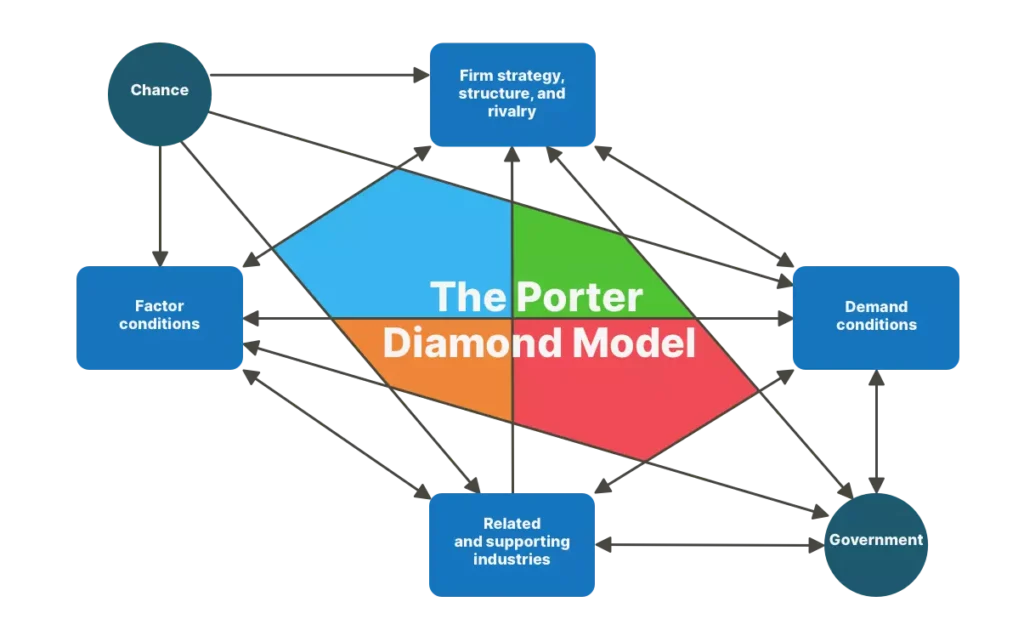The Porter Diamond model offers an effective way for analysing the national competitiveness. Based on the characteristics of the home country, it is possible to assess the international success of the firm.
According to the Porter Diamond model, the characteristics of the home country play a central role in explaining the international competitiveness of the firm. Thus, it asserts that the quality of the home country environment influence how successful the company can become in other markets.

The Porter Diamond model bases its assessment on six elements:
- Factor conditions
- Demand conditions
- Related and supporting industries
- Firm strategy, structure and rivalry
- Chance
- Government
Indeed, the home base of the company is an important determinant of a firm’s strengths and weaknesses relative to foreign rivals. The reason is that the home nation yields the company advantages and disadvantages and also shapes its likely future strategies.
The 6 Elements of the Porter Diamond Model
Factor conditions
Factor conditions are the first element of the Porter Diamond model. They refer to different types of resources that may or may not be present in the home country: human resources, physical resources, knowledge resources, capital resources and infrastructure. One can make the distinction between basic and advanced factors. Basic factors include natural resources (climate, minerals, oil) where the mobility of the factors is low. Although these factors may create the ground for international competitiveness, they can never turn into real value creation without the advanced factors. Advanced factors are more sophisticated, such as human resources (skills) and research capabilities. They are normally specific to the industry.
Demand conditions
Demand conditions, located in the right-hand box of the Porter Diamond model, involve such factors as early home demand, market size, market growth and sophistication. These characteristics can help companies create competitive advantage, for instance when sophisticated home market buyers pressure firms to innovate faster and to create more advanced products than those of foreign competitors.
In fact, a product’s fundamental or core design nearly always reflects home market needs. Often, the needs of the home market even shape the industry that later responds to global markets.
Related and supporting industries
Related and supporting industries can produce inputs that are critical for innovation and internationalization. These industries provide cost-effective inputs, but do also participate in the upgrading process, thus stimulating other companies in the chain to innovate.
The success of an industry is associated with the presence of suppliers and related industries within a certain region. For instance, the international competitiveness of the German automotive industry can be explained by the strong focus of the German industry on this sector.
Firm strategy, structure and rivalry
This element in the Porter Diamond model includes how companies are organized and managed, their objectives and the nature of rivalry in the home market. The way in which companies are established, set goals and are managed is critical to success on international markets. However, also the presence of intense rivalry makes companies competitive: it creates pressure. This triggers companies to innovate in order to maintain and upgrade competitiveness. To give an example: BMW, Mercedes-Benz and Audi would not be such successful brands if they did not have to compete against each other. Constant pressure from competition makes them develop competitive products, offer them at competitive prices and stay competitive on the whole.
Government
The government can have strong influence on the international competitiveness of a firm. In addition, it can influence each of the five other forces in the Porter Diamond model. The government of a country can either promote or hinder export. It can influence the supply conditions of key production factors. It can shape the demand conditions in the home market, as well as the competition between firms. These interventions can occur at local, regional, national, or even supranational level.
Chance
The final element in the Porter Diamond model is chance. Chance refers to random events that are beyond the control of the company. For the international competitiveness, they may be very important: the discontinuities created by chance may lead to advantages for some and disadvantages for other companies. Some firms may gain competitive positions, while others may lose.
When you take a look at the history of most industries, you will see that chance almost always plays a role. It starts with the question of who comes up with a major new idea first, which may very much be the result of a random event. For reasons that usually have little to do with economics, people typically start new businesses in their home countries. Once the industry begins in a certain country, scale and clustering effects may cement its position in that country.
Although each of the six factors of the Porter Diamond model may appear to be rather independent of the other factors, they must not be seen in isolation. Indeed, the factors are strongly interrelated.
The next step in understanding the company’s competitiveness is to investigate the competitive arena in the specific industry. This is represented in the top box of the Porter Diamond model. One of the most useful and best known frameworks for analysing the competitive structure and attractiveness of an industry is the Porter 5 Forces Model. Also, several factors can be identified that affect the intensity of competition in an industry.




